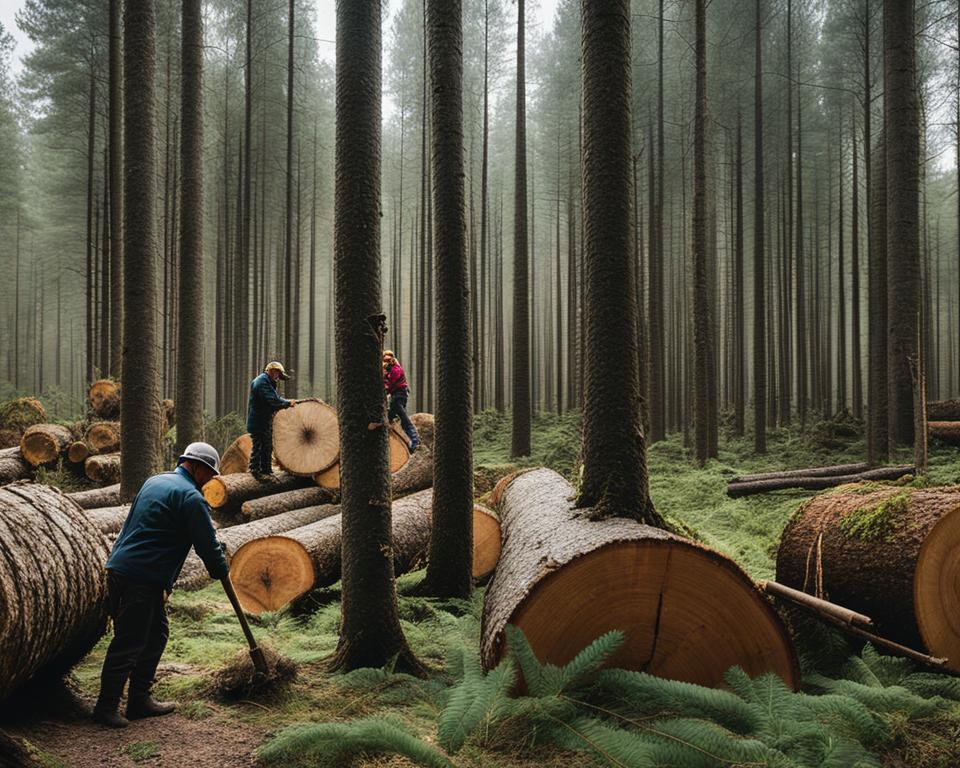The world’s forest ecosystems offer a multitude of benefits to human communities, wildlife, and the environment. Forests provide vital habitat for countless animal species, regulate the Earth’s climate, and sustain human livelihoods through economic activities such as timber and non-timber forest production. As we explore the many uses of the forest, we begin to understand the critical role these ecosystems play in sustaining our planet’s health and wellbeing.
Key Takeaways:
- Forests serve as crucial wildlife habitats, providing food, shelter, and nesting grounds for many animal species.
- Forests play a crucial role in regulating the Earth’s climate, absorbing carbon dioxide and producing oxygen.
- The timber and non-timber forest product industries provide economic benefits while sharing a responsibility to manage forest resources sustainably.
- Non-timber forest products include medicinal plants, nuts and fruits, and natural dyes, which have cultural and economic significance.
- Forests provide recreational opportunities and support conservation tourism, contributing to local livelihoods.
Wildlife Habitat
Forests are crucial habitats for a diverse range of animal species, contributing significantly to biodiversity conservation. The dense forests provide shelter, food, and nesting grounds for numerous animals and insects. Forests provide a conducive environment for the survival of a wide range of animal species, from endangered species like elephants and tigers to tiny insects that play a vital role in pollination. The intricate web of life in a forest ecosystem is a testament to the critical role of forests in maintaining the balance of natural systems.
The nesting grounds provided by forests are particularly essential for the survival of numerous bird species. Many bird species rely on a specific type of forest habitat for breeding, migration, and nesting. Without these habitats, many bird species would not survive. Additionally, forests that contain both deciduous and evergreen trees provide habitats for migratory birds throughout the year.

Biodiversity Conservation
Forests play a vital role in conserving biodiversity by providing habitats for a diverse range of animal and plant species. By ensuring the survival of a wide range of species, forests also ensure the balance and sustainability of the natural ecosystem. Forests offer a sanctuary to numerous endangered species, contributing to their protection and conservation. The loss of forest habitat is a significant concern as it may result in the extinction of many animal and plant species.
Climate Regulation
Forests play a vital role in mitigating climate change through carbon sequestration, which is the process of removing carbon from the atmosphere and storing it in plants, soil, and biomass. Trees absorb carbon dioxide through photosynthesis, and the carbon is stored in their trunks, branches, and leaves.
Moreover, forests also produce oxygen, which is essential for all life on earth. Trees release oxygen during photosynthesis, which balances the atmospheric gases and contributes to the overall oxygen supply. A mature tree can produce enough oxygen to support two human beings.
Deforestation and forest degradation can lead to a significant increase in atmospheric carbon dioxide levels, which contributes to global warming. The loss of trees and other vegetation not only removes a significant carbon sink but also releases stored carbon into the atmosphere, further exacerbating climate change.
Protecting and restoring forests is crucial for carbon sequestration, oxygen production, and climate regulation. By preserving and expanding forests, we can help mitigate the impacts of climate change and ensure a sustainable future for generations to come.

Timber and Forest Products
The timber industry and forest products play a significant role in the economy. Sustainable logging practices are essential to safeguard the environment and ensure a continuous supply of timber. The timber industry provides a variety of raw materials for making furniture, construction materials, and other wood-based products.
Forests are also vital to the paper and pulp industry, which produces paper, tissue paper, and cardboard. Without sustainable logging practices, we risk deforestation and loss of biodiversity.
As consumers, we can make a conscious effort to support sustainably harvested products. By choosing products from companies that support sustainable logging practices, we can support the timber industry while preserving the environment.

The Benefits of Sustainable Logging
- Sustainably harvested timber helps to reduce deforestation and maintain forest ecosystems
- Supports the livelihoods of people who depend on the forest industry
- Preserves biodiversity by safeguarding animal habitats and water resources
- Reduces greenhouse gas emissions by promoting carbon sequestration
Non-Timber Forest Products
Forests are treasure troves of useful products, and not all of them come in the form of timber. Medicinal plants, nuts and fruits, natural dyes, and other forest products all have cultural and economic significance. For generations, local communities have relied on these resources for sustenance and livelihoods.
Medicinal plants, in particular, have been used for centuries by indigenous communities to treat ailments and heal injuries. The dense biodiversity of forests allows for the discovery of unique plant species that can have significant medicinal properties.
Nuts and fruits are a vital food source, and forest ecosystems provide a rich selection of wild varieties. These products can be consumed fresh or processed into nutritious meals and snacks.
Natural dyes are another non-timber product derived from forests. They have been used for centuries to dye fabrics and materials, and they have cultural significance in many indigenous communities. These dyes can be made from a variety of plants and fungi.

Benefits to Local Communities
The collection and sale of non-timber forest products can provide a sustainable livelihood for many local communities. This practice allows communities to generate income without having to resort to the unsustainable practices of logging and land clearing.
Furthermore, the use of non-timber forest products helps to preserve traditional knowledge and cultural practices that have been passed down through generations. Supporting the use of these products can also contribute to the conservation of forest ecosystems and their biodiversity.
Recreation and Ecotourism
Forests are not only essential for ecological balance but also provide ample opportunities for recreational activities such as hiking and wildlife viewing. With numerous hiking trails scattered throughout forest areas, it is the ideal location for adventure enthusiasts.
Wildlife viewing is another exciting activity that draws people to forests. With a diverse range of flora and fauna, forests offer a glimpse of various animal species such as deer, bears, and birds. For conservation tourists, it is an excellent opportunity to learn about different conservation efforts and contribute to the cause.
Ecotourism, which is gaining popularity among nature lovers, has a significant positive impact on local communities. It generates revenue for local businesses and creates jobs, leading to economic growth. Additionally, it helps to preserve forests by raising environmental awareness and increasing public interest in conservation efforts.
Thus, forests serve not only as a resource for raw material and climate regulation but also offer recreational and ecotourism opportunities. By preserving and maintaining these ecosystems, we can ensure the continuity of these benefits for generations to come.




